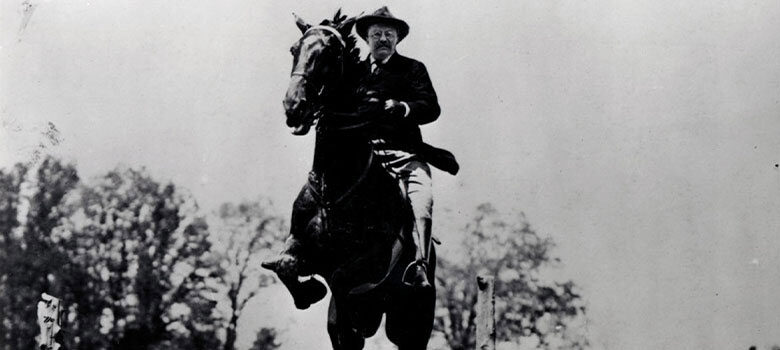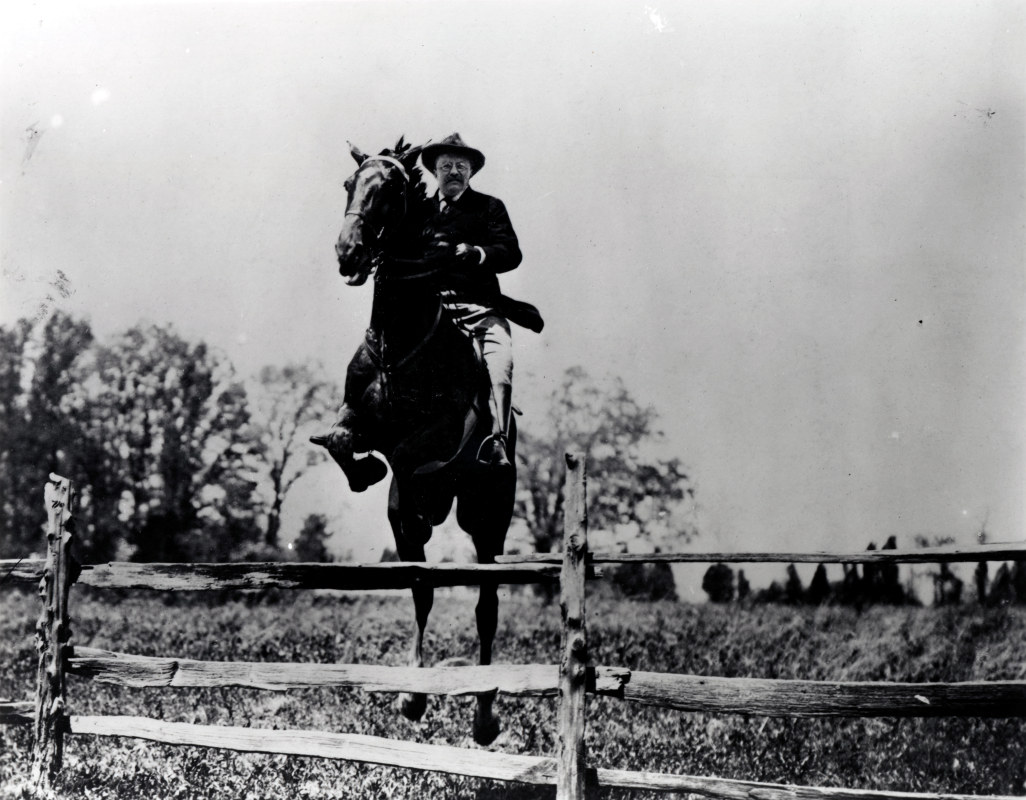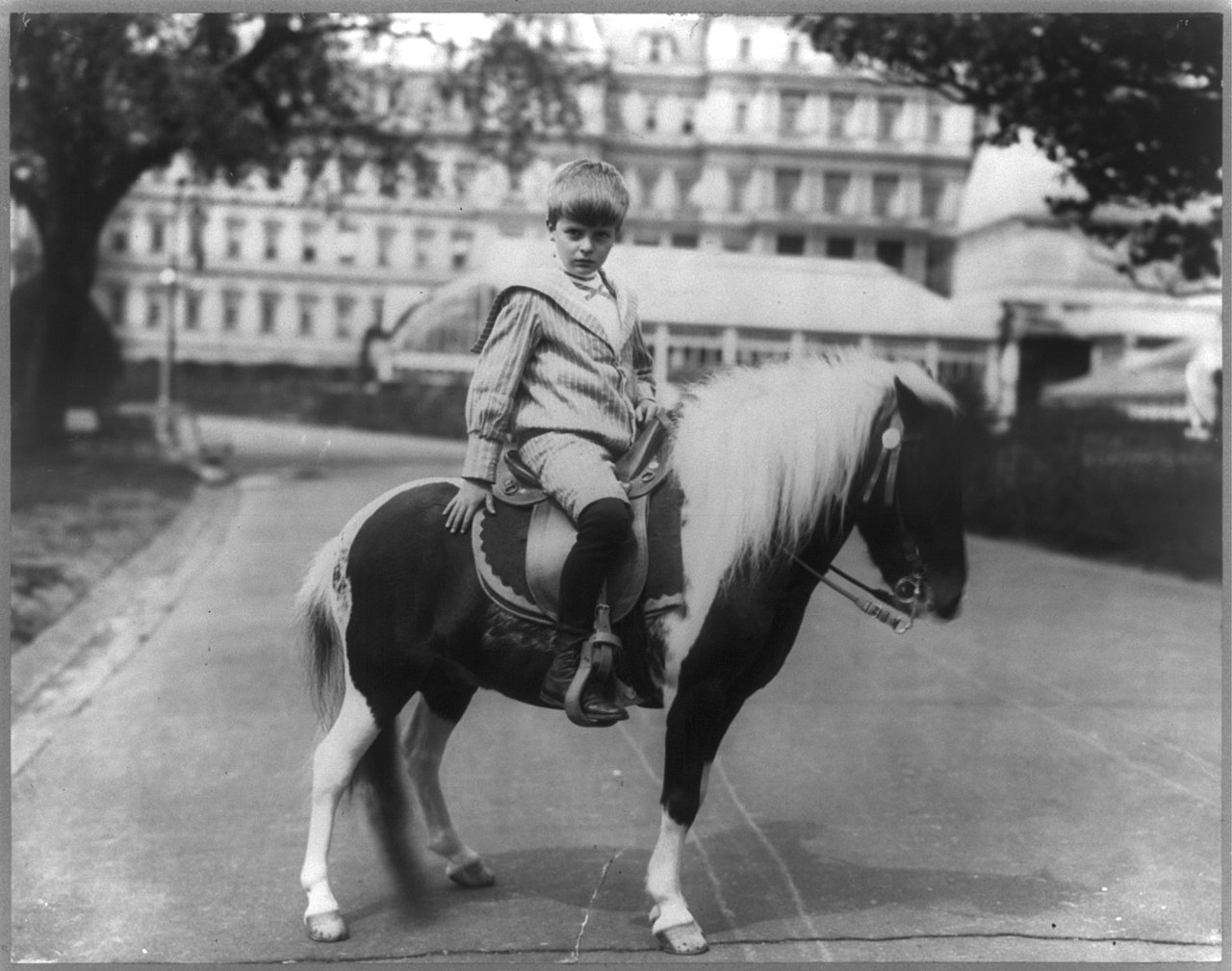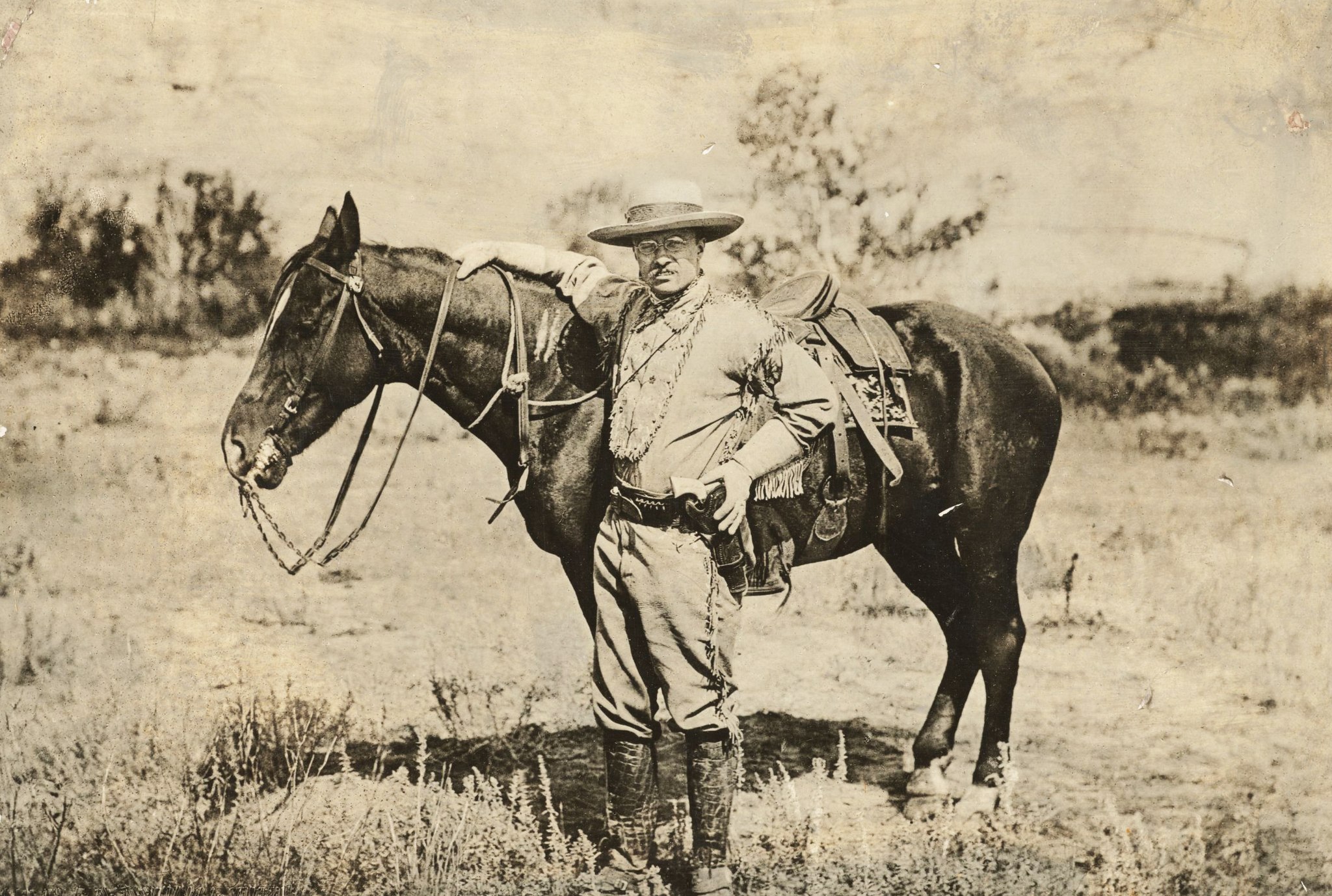Horsin’ Around

“Of course, there are no pets like horses; and horsemanship is a test of prowess.”
—Theodore Roosevelt

Bleistein
Theodore Roosevelt had many favorite horses throughout his life, but Bleistein tops the list. In a December 1903 letter to his son, Kermit, T.R. described Bleistein’s attributes and quirks. “Bleistein is really my favorite horse. He is such a gallant, spirited old fellow; but if I have three or four other horses in company and gallop him across fields, it is all I can do to hold him; and though he never refuses a fence, he sometimes goes through one instead of over it.”
Bred as a hunter, Bleistein was a light bay gelding who stood a little over 16 hands tall (one hand equals 4 inches, measured from the horse’s withers to the ground, making him slightly over 5 feet tall at the shoulders). He was a gift from T.R.’s friend George Bleistein, and like Rollo, the St. Bernard, Bleistein, the horse inherited the name of the man who gave the gift.
In a 1902 letter to George Bleistein, Roosevelt wrote, “I don’t know when I have ever received a gift out of which I get so much pleasure.”
T.R. was known to ride hell-bent-for-leather through Washington D.C.’s Rock Creek Park, often causing passers-by to scatter as he barreled past. Apparently, the 26th president practiced a healthy work/life balance, as one time, lured by a lovely spring day, he canceled a cabinet meeting to go riding—with a photographer in tow to capture him jumping obstacles in the park.
Though Bleistein had heart, one might argue he wasn’t the most stylish jumper. T.R. remarked, “Among the various horses I have owned in recent years, Bleistein was the one I liked best, because of his good nature and courage. He was a fair, although in no way a remarkable jumper.”
He may not have won a championship ribbon in the hunter ring at the Hampton Classic Horse Show, but he certainly won Theodore Roosevelt’s heart.
Renown
When he wasn’t riding Bleistein, T.R. was most likely aboard Renown, another bay gelding hunter he purchased for $600. Though Renown was an exceptionally well-bred horse, he did have a little trouble adjusting to city life in Washington D.C. In a 1902 letter to his daughter Ethel, Roosevelt wrote, “Renown is even quieter than Bleistein, but he still has fearful doubts about automobiles, and stands on his hind legs … when he meets one of unusually awful appearance [on] a solitary road.”
Being a horseman with great compassion for his animals, T.R. was patient with training Renown, using a positive reinforcement technique. In a letter to his family, chronicling his progress with his reactive mount, he wrote, “Renown is behaving better about automobiles and the like. I think the difference is largely in the way I handle him. He is a very good-natured and gentle horse, but timid and not over wise, and when in a panic his great strength makes him well-nigh uncontrollable. Accordingly, he is a bad horse to try to force by anything. If possible, it is much better to give him a little time, and bring him up as gently as may be to the object of terror. When he behaves well I lean forward and give him a lump of sugar, and now the old boy eagerly puts around his head when I stretch out my hand.”

Algonquin
Algonquin was a splashy, Calico Shetland pony with a light and dark, paint horse pattern coat. Secretary of the Interior Ethan Allen Hitchcock imported the flashy 8-year-old equine from Iceland as a gift to young Archie Roosevelt. Unlike Rollo and Bleistein, Algonquin was not named Hitchcock after the man who gave the gift. Standing at just 33 inches tall, Algonquin packed a lot of power in his tiny body. The Washington Post described the pony as “… a very good-natured, though spirited little beast …” Indeed, ponies can be feisty little creatures, smart, clever, and opinionated.
One day Algonquin went above and beyond in service to an ailing Archie. Recovering from measles, and confined to his room, Archie was down in the dumps. Not only was he sick and quarantined, but his mom denied his requests for an outing to the stables to visit his beloved Algonquin. So, older brother Kermit, and younger brother Quentin, devised a plan with White House Footman, Charles Reeder, to sneak the pony into the White House elevator and up to Archie’s bedroom to lift his spirits. Though Algonquin was skittish riding up to the second floor, he settled and gave Archie a much-needed boost. T.R. wrote, “[Archie] had a visitor the other day whose call will do more to restore him to health than all the medicine the doctor can give him.”
Ranch Horses
Surely, T.R. rode dozens of different horses during his cowboy years in the Badlands of Dakota, but from his prolific writing, two emerge as his favorites.
Muley
Muley was not only a cutting horse, and all-around ranch horse, but was also the horse Roosevelt rode to hunt game. There’s not much written about Muley’s appearance, and nature, except that he was a smaller horse, was handy, bold, and fit. In this excerpt from Outdoor Pastimes of an American Hunter, T.R. recalls hunting with the aging Muley in 1896.
“I rode out with my foreman, Sylvane Ferris. I was mounted on Muley. Twelve years before, when Muley was my favorite cutting pony on the round-up, he never seemed to tire or lose his dash, but Muley was now sixteen years old, and on ordinary occasions he liked to go as soberly as possible; yet the good old pony still had the fire latent in his blood, and at the sight of game—or, indeed, of cattle or horses—he seemed to regain for the time being all the headlong courage of his vigorous and supple youth …”
T.R. loved all horses, but he seemed to be particularly attracted to horses with one little quirk. Renown shied at automobiles. Bleistein occasionally plowed through jumps instead of over them. For Muley, it was gunfire—not a desirable trait in a game hunting horse, but Roosevelt took it in stride.
“Muley was a pet horse, and enjoyed immensely the gallop after game; but his nerves invariably failed him at the shot. On this occasion he stood snorting beside me, and finally, as the deer came in sight, away he tore—only to go about 200 yards, however, and stand and watch us, snorting with his ears pricked forward until, when I needed him, I went for him,” T.R. wrote.
When Roosevelt sold his ranch to Sylvane Ferris, his longtime foreman, he left Muley and several other now-aged ranch horses in his care, writing “…I wish you or Joe would just keep them and use them. They are old now and I hate to sell them just to be knocked about and ridden to death.”
Muley died in 1907, having lived a long life. Upon hearing of his death from Joe Ferris, Sylvane’s brother, T.R. expressed his sympathy and gratitude for his taking care of “Old Muley.”

Manitou
Not much is known about Manitou, except that he was a favorite of T.R.’s during his time in the Badlands. In an excerpt from an essay that Roosevelt wrote about his ranch and the cowboy life for Century Magazine in 1888, he talks about Muley and Manitou’s behavior when all the ranch horses are herded into a corral to be saddled for a day’s work, and Manitou’s humorous affection for a certain food.
“My pet cutting pony, little Muley, and good old Manitou, my companion in so many hunting trips, will neither of them stay with the rest of their fellows that are jamming and jostling each other … but they very sensibly stand quietly with the men in the middle … Both are great pets, Manitou in particular; the wise old fellow being very fond of bread and sometimes coming up of his own accord to the ranch house and even putting his head into the door to beg for it.”
In a February 2017 audio interview with The Horse Network’s radio program, The Stable Scoop: An Equestrian Roundtable, Gayle Stewart, author of 100 Horses in History, tells about a time Theodore Roosevelt riding Manitou, needed to cross the cold and turbulent Little Missouri River. Advisers told him to use a railroad bridge, but it was too out of the way for T.R. Instead, he guided his trusty mount to a submerged dam and gingerly started the walk across the river. However, Manitou took a wrong step, and horse and rider toppled into the raging waters. When both surfaced, T.R. swam in front of Manitou, guiding him to the other shore, all while fighting swirling, frigid water, and pushing huge chunks of ice out of the way. Sound like a harrowing experience? Not for Roosevelt! He must have thought it was great sport—because, two days later, he made the same crossing, just for the fun of it. Clearly, Manitou and he shared a close bond of trust.
Stewart quoted T.R. about his love for Manitou. “My own hunting horse Manitou is the best and most valuable animal on the ranch. He’s stoutly built and strong and able to carry a good-sized buck behind his rider at a lope without minding in the least. Enduring, hearty, sure-footed, willing, spirited, gentle … Manitou is a treasure and I value him accordingly.”
Other Horses Loved by the Roosevelt Family
Wyoming, a gift from the citizens of Douglas, Wyoming.
Yangenka, a bay mare, loved and ridden by First Lady Edith Roosevelt.
Additional stablemates:
Jocko Root, Grey Dawn, and carriage horses, General and Judge, among many, many others!
Theodore Roosevelt was the last president to keep a full stable of horses at the White House. He was an excellent horseman and avid rider. Sometimes, after he finished his work, the president would strap on his spurs, slip on his gloves, head straight to the barn, mount up, and ride—not even taking the time to change out of his suit! Being a conservationist and outdoorsman, he worried about rapid development in Washington and losing open spaces to ride.
|
Fun Trivia! Women Who Rode Like Cowboys! In the East, it was customary for women to ride and jump horses sidesaddle. In May 1903, President Theodore Roosevelt traveled through New Mexico, Arizona, and California where he witnessed women riding just like men. Makes one wonder, did the Marquis’ wife, Medora, ride sidesaddle in the Dakotas? In this letter to his daughter, Ethel, T.R. wrote: “By the way, tell mother that everywhere out here from the Mississippi to the Pacific I have seen most of the girls riding astride, and most of the grown-up women. I must say I think it very much better for the horses’ backs. I think by the time that you are an old lady the sidesaddle will almost have vanished—I am sure I hope so.” |
 |
 |



